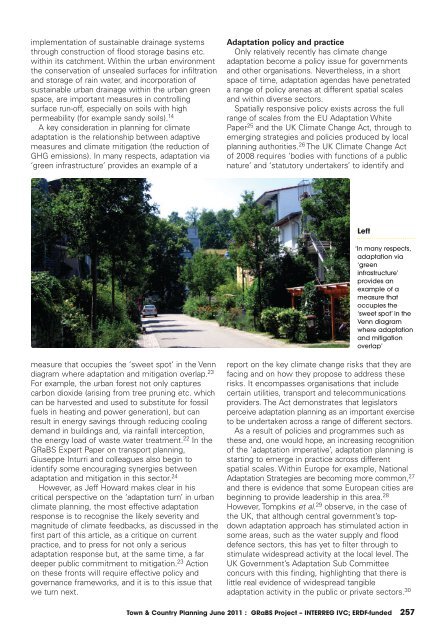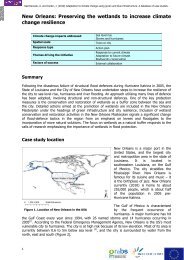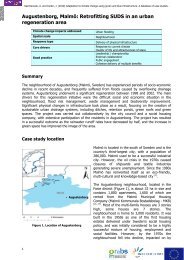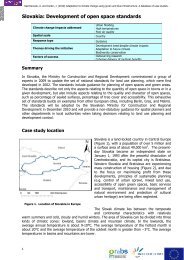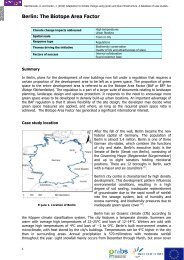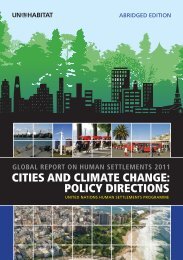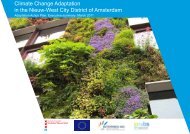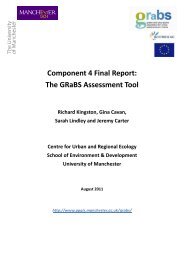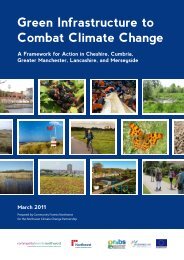Download - GRaBS
Download - GRaBS
Download - GRaBS
Create successful ePaper yourself
Turn your PDF publications into a flip-book with our unique Google optimized e-Paper software.
implementation of sustainable drainage systems<br />
through construction of flood storage basins etc.<br />
within its catchment. Within the urban environment<br />
the conservation of unsealed surfaces for infiltration<br />
and storage of rain water, and incorporation of<br />
sustainable urban drainage within the urban green<br />
space, are important measures in controlling<br />
surface run-off, especially on soils with high<br />
permeability (for example sandy soils). 14<br />
A key consideration in planning for climate<br />
adaptation is the relationship between adaptive<br />
measures and climate mitigation (the reduction of<br />
GHG emissions). In many respects, adaptation via<br />
‘green infrastructure’ provides an example of a<br />
Adaptation policy and practice<br />
Only relatively recently has climate change<br />
adaptation become a policy issue for governments<br />
and other organisations. Nevertheless, in a short<br />
space of time, adaptation agendas have penetrated<br />
a range of policy arenas at different spatial scales<br />
and within diverse sectors.<br />
Spatially responsive policy exists across the full<br />
range of scales from the EU Adaptation White<br />
Paper 25 and the UK Climate Change Act, through to<br />
emerging strategies and policies produced by local<br />
planning authorities. 26 The UK Climate Change Act<br />
of 2008 requires ‘bodies with functions of a public<br />
nature’ and ‘statutory undertakers’ to identify and<br />
Left<br />
‘In many respects,<br />
adaptation via<br />
‘green<br />
infrastructure’<br />
provides an<br />
example of a<br />
measure that<br />
occupies the<br />
‘sweet spot’ in the<br />
Venn diagram<br />
where adaptation<br />
and mitigation<br />
overlap’<br />
measure that occupies the ‘sweet spot’ in the Venn<br />
diagram where adaptation and mitigation overlap. 23<br />
For example, the urban forest not only captures<br />
carbon dioxide (arising from tree pruning etc. which<br />
can be harvested and used to substitute for fossil<br />
fuels in heating and power generation), but can<br />
result in energy savings through reducing cooling<br />
demand in buildings and, via rainfall interception,<br />
the energy load of waste water treatment. 22 In the<br />
<strong>GRaBS</strong> Expert Paper on transport planning,<br />
Giuseppe Inturri and colleagues also begin to<br />
identify some encouraging synergies between<br />
adaptation and mitigation in this sector. 24<br />
However, as Jeff Howard makes clear in his<br />
critical perspective on the ‘adaptation turn’ in urban<br />
climate planning, the most effective adaptation<br />
response is to recognise the likely severity and<br />
magnitude of climate feedbacks, as discussed in the<br />
first part of this article, as a critique on current<br />
practice, and to press for not only a serious<br />
adaptation response but, at the same time, a far<br />
deeper public commitment to mitigation. 23 Action<br />
on these fronts will require effective policy and<br />
governance frameworks, and it is to this issue that<br />
we turn next.<br />
report on the key climate change risks that they are<br />
facing and on how they propose to address these<br />
risks. It encompasses organisations that include<br />
certain utilities, transport and telecommunications<br />
providers. The Act demonstrates that legislators<br />
perceive adaptation planning as an important exercise<br />
to be undertaken across a range of different sectors.<br />
As a result of policies and programmes such as<br />
these and, one would hope, an increasing recognition<br />
of the ‘adaptation imperative’, adaptation planning is<br />
starting to emerge in practice across different<br />
spatial scales. Within Europe for example, National<br />
Adaptation Strategies are becoming more common, 27<br />
and there is evidence that some European cities are<br />
beginning to provide leadership in this area. 28<br />
However, Tompkins et al. 29 observe, in the case of<br />
the UK, that although central government’s topdown<br />
adaptation approach has stimulated action in<br />
some areas, such as the water supply and flood<br />
defence sectors, this has yet to filter through to<br />
stimulate widespread activity at the local level. The<br />
UK Government’s Adaptation Sub Committee<br />
concurs with this finding, highlighting that there is<br />
little real evidence of widespread tangible<br />
adaptation activity in the public or private sectors. 30<br />
Town & Country Planning June 2011 : <strong>GRaBS</strong> Project – INTERREG IVC; ERDF-funded 257


